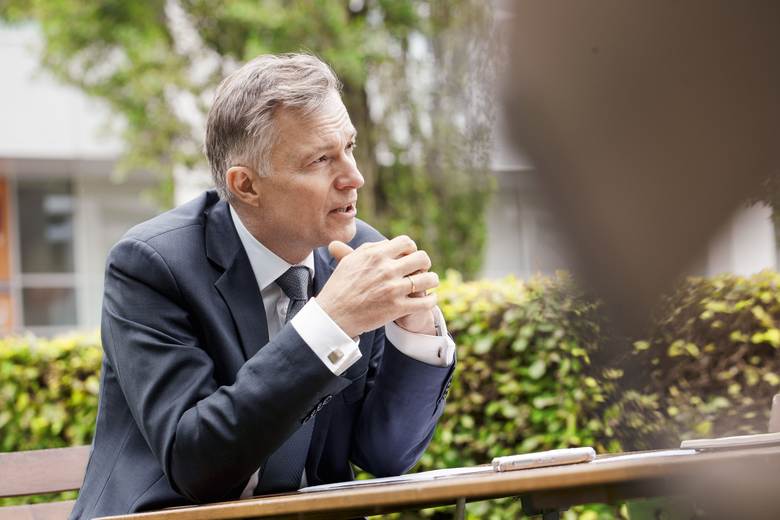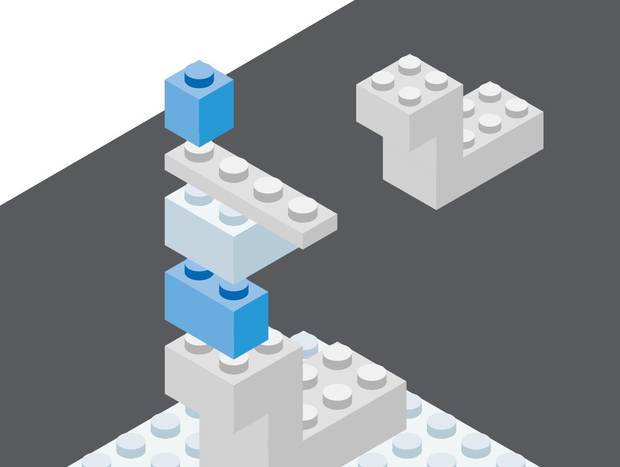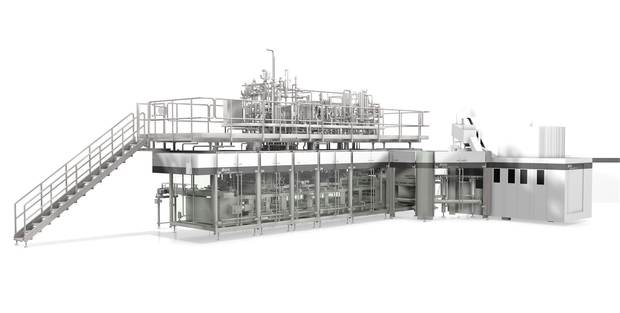Which expectations do today’s consumers have regarding the sustainability of beverage packaging?
Consumers not only expect that brand manufacturers possess the normal regulatory licenses but also a social license to operate – in other words, that they’re accepted as a sustainable brand by consumers, NGOs* and other stakeholders. In the beverage industry this applies to the packaging in particular.
How has beverage packaging changed over the course of time as regards ecology?
For years manufacturers have been committed to improving beverage packaging’s ecological footprint. Its weight especially has been considerably reduced. Efforts have been made to also collect non-returnable bottles after use and recycle them. Bottle-to-bottle recycling systems have been developed for plastic PET bottles in order to supplement PET recyclate as a secondary raw material in the production of preforms and bottles. Another improvement to the PET bottle has been to introduce processes which make plastic from renewable raw materials. One example of this is the PlantBottle™ developed by Coca-Cola, another the manufacture of PEF by Synvina, a joint undertaking by BASF and Avantium.
Here, plastic bottles are made of a combination of recyclate on the one hand and renewable raw materials on the other, thus greatly reducing their ecological footprint.
“Plant-based plastics can be biodegradable but don’t have to be.”
What role do plant-based plastics play when it comes to sustainability and would a compostable bottle not be the best solution?
First of all, we have to clear up a common misconception. Plant-based plastics can be biodegradable but don’t have to be. Nowadays you can make various plastics from all kinds of biomass, such as organic PET or PEF, but they’re not biodegradable. Plastics which are, such as PLA, are more permeable to CO₂, water and oxygen and thus of only limited use for beverage applications. In contrast, materials made from fossil sources which are biodegradable have been around for some time now, such as ecoflex® from BASF. These don’t play a role in the beverage sector, however.
Is there a flip side to bio-based plastics?
Renewable raw materials are needed to make bio-based plastics. These are either specifically cultivated, like sugar cane, for example – we call this the first generation – or biological plant waste is used, known as second-generation biomass. With the first generation we have to make sure that cultivation is sustainable. No rain forest must be cleared for this purpose and the area under cultivation mustn’t compete with food production. In order to ensure this there are extensive certification systems in force, such as Bonsucro™ for cane sugar.
With the second generation, i.e. the use of plant waste, we don’t have these problems. In the meantime people are working on a third generation, for example with algae, which absorbs CO₂ from the atmosphere and turns it into biomass.
One important criterion in the biological evaluation of a material is its ecobalance which assesses a number of environmental influences. These include CO₂ emissions, water consumption, fine dust particles and eutrophication*. As opposed to materials based on fossil sources, bio-based plastics considerably cut down on CO₂ emissions yet consume more water. The aim is to find the right balance between all the factors which influence our environment.
Which trends and developments are foreseeable or imaginable?
In the future the combination of the material recycling system on the one hand and the biological cycle as a supplier of raw materials for biomass on the other will play a major role. Beyond this we don’t know which totally new ideas might shake up the market in the next ten years. Systems which provide beverage concentrates similar to our well-known coffee capsules are gaining in significance all over the world. With these consumers can make their own carbonated beverages at home – in a machine or by unscrewing a form of cartridge on a bottle of water. On developed markets with high-quality drinking water this reduces the amount of packaging material and saves on transportation, both of which can have a positive impact on the ecobalance. More advanced ideas on the micro- or nanoproduction of soft drinks at home are more of a vision than a trend but tackle the same question: why do I have to insist on the bottle at home where 70% to 80% of all consumption takes place?
What benefits do bio-based plastics have for the beverage industry?
They liberate us from oil and reduce CO₂ emissions. In this sense biomass extracts carbon dioxide from the atmosphere by photosynthesis and ‘binds’ it in the bottle. Recycling works in a similar fashion: if I don’t burn my plastic waste – which is only allowed in Europe if energy can be recovered through steam or electricity, for example – then the bonded CO₂ remains trapped in the plastic bottle cycle. For biodegradable plastics which are composted the reverse applies as this is a ‘cold’ combustion process, in which microorganisms metabolize the plastic and emit CO₂ in doing so. This is then offset in the ecobalance.
Who are the main drivers of this development and which interests do they pursue?
LOHAS** definitely plays a certain role here: those interested consumers who are conscious of the fact that packaging is not allowed be thrown onto the street, into the sea or burned. Their views are supported by various NGOs and so-called ‘campaigners’. While the latter want to make their mark by showing up the industry – and in doing so they occasionally distance themselves from the facts – NGOs pinpoint the ecological weak points and contemplate possible remedies to these in a fair process together with companies. One big step is the public awareness which the Ellen MacArthur Foundation has created for the notion of the circular economy. There are many good approaches which sometimes suffer from companies’ cumbersome operative implementation thereof, however. Here, NGOs take on the function of eliciting promises from these companies.
Which demands do these developments make of machinery and systems manufacturers?
From the present perspective the whole issue is more a matter of chemistry than mechanical engineering as long as we’re able to find what are known as drop-in solutions which function within the existing infrastructure. PET preform or stretch blow molding machines also work with bio PET or PEF. While nothing has to be altered in the recycling system for bio PET, with increasing quantities there will have to be an additional recycling setup for PEF. It’s possible to separate them with existing systems, however. Being able to fall back on existing investments throughout the entire value chain is what makes bio PET and PEF so brilliant. You can thus not only view the effects of ecology and economy from a vertical angle but must also approach the value chain horizontally and think about how we can make this material a success together. To this end, for example, manufacturers must commit to the long-term purchase of bioplastics and recyclate so that recyclers don’t have to bear the economic risk alone.
What’s happening in countries which at present are less exemplary in their recycling efforts?
The pressure to collect the material on the market will increase here, too. Littering is being increasingly considered a nuisance and marine littering or marine pollution especially is finding wide coverage in the media. Even if this phenomenon is not limited to plastic bottles, big brand beverage containers are in focus through the work done by campaigners. As part of the ERP*** process manufacturers are being called to account. The discussion on deposit systems has therefore increased worldwide and it’s expected that not just 30%, 40% or 50% of all PET bottles can be fed back into the recycling system but over 90%.
“In the future the sustainable plastic bottle will comprise a mixture of recyclate and bio-based plastic.”
Which successful examples does the beverage industry have to show?
We can find good examples where bio PET is in commercial use – in Germany, for instance, in the VIO beverage brand, which uses 100% bio PET 30 – or where recyclate is used intensively – such as in Coca-Cola Life, where the 1.5-liter bottle is made of 100% recycled raw materials.
How much more are consumers prepared to pay for an ecologically sustainable form of packaging?
Nobody wants to pay a higher price. Consumers naturally expect beverage producers to exercise their ecological, social and economic responsibility. To some extent this is factored into the price. On the other hand, not keeping to their social license to operate and disappointing expectations when it comes to sustainability result in the manufacturer being punished.
What chance do you think the bio-based bottle has?
An excellent one. When the concept evolved at Coca-Cola in the USA, with beverage producers it triggered the start of a veritable bio-economy. The initial focus was on doing away with oil-based raw materials in favor of renewable ones. However, even a bio-based bottle has to be collected after use and recycled. Ongoing technical development will further improve access to renewable raw materials and allow a fully-fledged bio-based plastic bottle to be produced at a competitive price. In the future the sustainable plastic bottle will comprise a mixture of recyclate and bio-based plastic. Whether this will be PET, PEF or another type of plastic yet to be developed in the lab, only the future will tell. Whatever the case, a drop-in solution will considerably ease the launch thereof.
This interview was conducted by ‘KHS competence’ editor Stuart J. Nessbach.



























